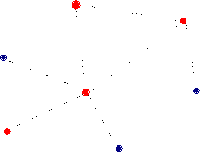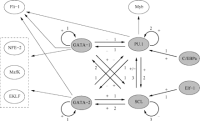ResearchResearch Projects
The following are examples of projects that the Center of Engineering and Health have conducted:
EpiMoRPH: A simulation environment for generating spatially refined intervention strategies for the control of infectious disease
Lead PI: Sanjay Mehrotra
The goal of this project is to develop the facility location optimization models with the help of a graduate student at Northwestern University, and in collaboration with the PI as well as co-PI at Arizona State University. We will also help in getting the developed models implemented through proper calibration, identification of appropriate modeling and solution analysis tools using appropriate algorithmic approaches to solving the developed models. The coordinated effort with the PI and the co-PI at ASU will also help parametrize and calibrate the developed models in single and multi-objective optimization settings. The models with will developed and implemented using appropriate modeling tools such as ampl, amplypy (using python) and model solvers such as gurobi and cplex.
Equitable and Efficient Scarce Resource Allocation Using Stochastic Fractional Optimization
Lead PI: Sanjay Mehrotra
The objective function in a fractional program consists of a model where the numerator and the denominator are functions of decision variables. Fractional programming has been used to model problems from diverse areas. They arise as blending models ensuring certain consistency in the blended raw materials, inventory/sales ratio optimization in production planning, cutting-stock problems minimizing the trim-loss to produced quantity ratio, information theory, return on investment optimization models, return to risk ratio maximization models, debt to equity ratio models, macroeconomic planning, transportation planning, etc. An important application that models the problem as fractional program arises from Data Envelopment Analysis used to measure efficiency of decision units. Robust counterparts to the fractional optimization problems have also been used, e.g., in tree-structured network design problems.
The fractional programming model is stochastic when the parameters giving expressions for the numerator and denominator functions follow some probability distribution. The goal of this research is to develop and study novel methods for efficiently obtaining solutions of stochastic fractional programs. The research also studies the distributionally robust and chance constrained counterparts of the problem.
LIVOPT: LIVer cirrhosis Optimizing Prediction of Patient OuTcomes
Lead PI: Daniela Ladner
Cirrhosis is a leading cause of mortality in the United States (US), diagnosed in millions of people and resulting in over 40,000 deaths each year, predominately in older people. These patients are at higher risk of serious complications (e.g. infection, ascites, hepatic encephalopathy), hospitalization and death. Little is known about the epidemiology and disease progression and older patients are more vulnerable and might have different risk profiles. The clinical challenge is to accurately and early predict who is at highest risk for requiring hospitalization and/or death and understanding how this might be different in older versus younger adults. . One barrier to date has been the lack of an epidemiologically representative patient sample that captures those with cirrhosis and goes beyond one health system, as many data repositories are skewed or limited: CMS only captures elderly and those with debility, NIS does not allow longitudinal observation, UNOS represents less than one percent of those with cirrhosis. Hence, we will build on our previous work to use a unique dataset, the Chicago Area Patient-Centered Outcomes Research Network (CAPriCORN). CAPriCORN captures the electronic health records (EHR) from nine health systems from 2011-present (incl. academic center, county, VA and private), catching most of the diverse patient population in the greater Chicago metropolitan area, namely ~160,000 patients with liver cirrhosis. The dataset is extensive, allowing the use of traditional (e.g., regression) and novel analytical techniques (e.g. deep learning) to pursue the aims of the study. We aim to model cirrhosis progression in the elderly and to predict the risk of hospitalization and death in older patients with cirrhosis. We also aim to perform sub-group analyses focusing on race and socioeconomic factors in the elderly. The impact of accurate and early prediction of mortality and hospitalization risk in elderly patients with cirrhosis allows for targeted interventions of the most vulnerable patients to improve outcomes.
Optimizing Hospital-to-Hospital Transfer Processes for ICU patients with Acute Respitory Failure
Lead PI: Nandita Nadig
Every year 2.5 million patients are admitted to an ICU with Acute Respiratory Failure (ARF). About 1 in 30 of these patients undergoes a transfer from a community hospital to a tertiary hospital, projecting improved quality and survival. Despite frequent transfers, there is no uniform guidance to help clinicians decide why, when, or how ARF patients should be ideally transferred. Moreover, each interface has opportunities for implicit and explicit bias leading to disparities in patient outcomes and transfer rates for under-represented populations. Our prior work with patients, families, and clinicians calls for a great need to standardize the process as well as improve communication and engagement with family to optimize patient care during transfer.
Therefore, our study will proactively address principles of equity and aim to develop and refine a standardized approach to hospital-to hospital transfer of ARF patients. To achieve this, we will study a population of patients, families and clinicians involved in transfer and utilize our collaborative team with health systems engineers to identify the distinct decision points, actions and steps involved in the transfer process. Finally, we will assess acceptability of this standardized approach and measure patient-survival, clinician-communication and family-satisfaction during transfer.
Rescuing Kidneys at Risk of Discard
Lead PI: Sanjay Mehrotra
Kidney transplantation (KT) is a superior alternative to dialysis for many patients with respect to longevity, quality of life, morbidity, and the cost of End-Stage Renal Disease (ESRD) care. However, of the 95,000 patients waitlisted for a KT in 2017, less than 20,000 received a KT. In the same year, about 4,000 patients died, while another 4,700 were removed from the waitlist because they were considered too sick to transplant. Despite the long waitlist, more than 3,500 (19%) of the deceased donor kidneys were discarded. “No Recipient Found” was the stated reason for discarding 1,325 of the donated kidneys. The discard rate increases significantly for the low-quality kidneys, reaching as high as 60% for the kidneys in the lowest quality decile. This discard occurs even though many discarded kidneys, even those in the lowest quality decile, would have conferred significant survival benefits to some recipients relative to remaining on dialysis.
The current kidney allocation system does not efficiently allocate kidneys at high risk of discard. The patient prioritization algorithm does not quickly identify patients who will benefit most from such kidneys, and the donated kidneys are wasted. Improvements to the kidney allocation system are needed to reduce the number of discarded kidneys while allocating them equitably to patients who would most benefit. However, revising allocation policy is challenging because patients and transplant professionals must weigh the risks and benefits of accepting a low-quality kidney against the risks of waiting for a much higher quality kidney. The transplant community and patient preferences in accepting low-quality kidneys are unknown.
This study is developing kidney allocation algorithms that rescue viable deceased donor kidneys from discard. The developed algorithms will (i) identify kidneys at risk of discard using measures such as Kidney Donor Profile Index, or a novel Kidney Discard Risk Score; (ii) identify patient populations, such as those with longer waiting times to transplant or low functional status, who will benefit the most from viable kidneys. Preferences of the transplant clinicians (Surgeons and Nephrologists) and patients (on dialysis and transplant recipients) will be elicited using discrete-choice experiments that will quantify allocation efficiency and fairness tradeoffs for kidneys at risk of discard. A discrete event simulation software engine will be developed. The simulation engine will incorporate transplant center and patient-specific kidney acceptance behaviors, and the developed allocation algorithms. The benefits of different allocation algorithms will be evaluated in the simulation.
Bed Angle Detection in Hospital Room Using Microsoft Kinect V2
This research will focus on bed angle detection in hospital room automatically using the latest Kinect sensor. The developed system is an ideal application for nursing staff to monitoring the bed status for patient, especially under the situation that the patient is alone. The patient bed is reconstructed from point cloud data using polynomial plane fitting. The analysis to the detected bed angle could help the nursing staff to understand the potential developed hospital acquired infection (HAI) and the health situation of the patient, and acquire informative knowledge of the relation between bed angle and disease recovery to decide appropriate treatment strategy.
Analysis of Kidney Transplant Centers in The United States

Currently, there are more than 570,000 patients suffering from End Stage Renal Disease (ESRD) in the United States. For most ESRD patients, the only known cure for their disease is a kidney transplant. The distance patients must travel to a kidney transplant center is predictive of the patient receiving a kidney transplant. This study analyzes the current geographic distance traveled by the ESRD population to 240 kidney transplant centers in the continental US, and is the first to use location theory to analyze where kidney transplant centers should optimally be located to increase geographic assess of patients to transplantation services.
Resident Rotation Policies and Continuity of Care in Vascular Surgery

Surgical residents often graduate with a limited set of operating room experiences. The experiences they do have are typically characterized by low "continuity of care," meaning that it's unlikely that for a given surgery the resident had never been involved in the patient's diagnosis. Simulation, empirical studies, and an analytical model show that this is due to several easily remedied logistical conundrums as well as short resident rotation lengths.
Contact Tracing to Control Infectious Diseases

Contact tracing is a primary means of controlling infectious diseases such as tuberculosis, human immunodeficiency virus, and sexually transmitted diseases. The effectiveness of contact tracing depends on a number of factors including the contact tracing policy used, the social mixing network, and characteristics of the disease (e.g., the transmission mechanism, variability in infectiousness over time and across individuals, and the rate at which symptoms develop). We develop a simulation model for contact tracing and use it to explore the effectiveness of different contact tracing policies in a budget-constrained setting. We evaluate several alternative contact tracing policies, introduce a cost-effectiveness framework and show how it can be used to determine the optimal level of investment in contact tracing.
Inference on Gene Regulation

Proteins are the primary regulatory agents of transcription even though mRNA expression data alone, from systems like DNA microarrays, are widely used. In addition, the regulation process in genetic systems is inherently non-linear in nature, and most studies employ a time-course analysis of mRNA expression. These considerations should be taken into account in the development of methods for the inference of regulatory interactions in genetic networks.
Formulating Adaptive Radiation Therapy (ART) Treatment Planning into a Closed-Loop Control Framework
While ART has been studied for years, the specific quantitative implementation details have not. In order for this new scheme of radiation therapy (RT) to reach its potential, an effective ART treatment planning strategy capable of taking into account the dose delivery history and the patient’s on-treatment geometric model must be in place. This paper performs a theoretical study of dynamic closed-loop control algorithms for ART and compares their utility with data from phantom and clinical cases.
Adding Extrinsic Goals to the QALY Model
Methods for evaluating health quality are central to medical cost-effectiveness analyses. The most important such method is the quality-adjusted life year (or QALY), in which a patient's length of life is given weight proportional to quality of health. However, numerous studies have demonstrated that the correlation between measured QALYs and a patient's current health is at best modest. Moreover, it is known that individuals may trade lifetime for improved health quality when remaining lifetime is long, but not when it is short; and that those with poor health quality may prefer to survive only until important life milestones are achieved and no longer. To address these concerns, the investigators will examine methods for incorporating life goals into health preference models.
